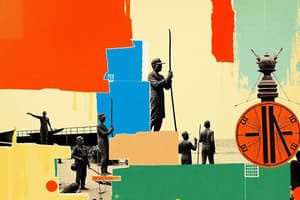Podcast
Questions and Answers
What are the three islands that make up the Eastern Visayas Region?
What are the three islands that make up the Eastern Visayas Region?
- Cebu, Bohol, and Siquijor
- Mindanao, Luzon, and Visayas
- Leyte, Samar, and Biliran (correct)
- Negros, Panay, and Masbate
What is the capital of Eastern Samar?
What is the capital of Eastern Samar?
Borongan
What is the nickname of Tacloban City?
What is the nickname of Tacloban City?
The Princess City
The Eastern Visayas Region is located in the western part of the Philippines.
The Eastern Visayas Region is located in the western part of the Philippines.
Which of these cities is NOT located in the Eastern Visayas region?
Which of these cities is NOT located in the Eastern Visayas region?
What is the name of the traditional dance that is popular among Waray people?
What is the name of the traditional dance that is popular among Waray people?
Where did Ferdinand Magellan first land in the Philippines?
Where did Ferdinand Magellan first land in the Philippines?
Which island is known for its vast plains, while Leyte is known for its mountains?
Which island is known for its vast plains, while Leyte is known for its mountains?
What is the name of the indigenous martial art practiced by the Waray people?
What is the name of the indigenous martial art practiced by the Waray people?
What is the name of the traditional tradition in the Eastern Visayas that involves bringing food to sell in a market at a low cost?
What is the name of the traditional tradition in the Eastern Visayas that involves bringing food to sell in a market at a low cost?
The Eastern Visayas has traditional dance and music forms, but no traditional literature or oral stories.
The Eastern Visayas has traditional dance and music forms, but no traditional literature or oral stories.
What is the name of the traditional festival in Tacloban City?
What is the name of the traditional festival in Tacloban City?
Flashcards
Eastern Visayas region
Eastern Visayas region
A region in the Philippines comprising the islands of Leyte, Samar, and Biliran.
Leyte Island
Leyte Island
An island in Eastern Visayas, often divided into Northern and Southern Leyte.
Samar Island
Samar Island
An island in Eastern Visayas with Northern, Western, and Eastern divisions.
Biliran Island
Biliran Island
Signup and view all the flashcards
Catbalogan
Catbalogan
Signup and view all the flashcards
Tacloban
Tacloban
Signup and view all the flashcards
Maasim
Maasim
Signup and view all the flashcards
Waray-waray
Waray-waray
Signup and view all the flashcards
Arnis
Arnis
Signup and view all the flashcards
Tacloban City
Tacloban City
Signup and view all the flashcards
Pintados
Pintados
Signup and view all the flashcards
Homonhon Island
Homonhon Island
Signup and view all the flashcards
Isla ng Limasawa
Isla ng Limasawa
Signup and view all the flashcards
Mount Lobi
Mount Lobi
Signup and view all the flashcards
Guinhangdan Hill
Guinhangdan Hill
Signup and view all the flashcards
Tinikling
Tinikling
Signup and view all the flashcards
Kuratsa
Kuratsa
Signup and view all the flashcards
Waray Literature
Waray Literature
Signup and view all the flashcards
Ambahan
Ambahan
Signup and view all the flashcards
Bakayaw
Bakayaw
Signup and view all the flashcards
Taber
Taber
Signup and view all the flashcards
Mount Suiro
Mount Suiro
Signup and view all the flashcards
Rice
Rice
Signup and view all the flashcards
Fishing
Fishing
Signup and view all the flashcards
Daniel Z. Romualdez Airport
Daniel Z. Romualdez Airport
Signup and view all the flashcards
Study Notes
Region VIII (Eastern Visayas)
- Eastern Visayas is comprised of Leyte (North and South), Samar (North, West, and East), and Biliran.
- Provinces include:
- Western Samar (Catbalogan)
- Northern Samar (Catarman)
- Eastern Samar (Borongan)
- Northern Leyte (Tacloban)
- Southern Leyte (Maasim)
- Biliran (Naval)
- Located in the eastern part of the Visayas archipelago.
- Borders the Bicol Peninsula to the north, the Pacific Ocean to the east, Surigao to the south, Bohol to the southwest, Camotes Sea to the west, and the Visayas Sea to the northwest.
- Faces the Pacific Ocean, which is a common path for typhoons that pass through the Philippines.
- Often affected by typhoons due to its location in the "Typhoon Belt."
- Features mountainous terrain, deep valleys, and coastlines.
- Known as the "Cradle of History" due to historical events like Magellan's arrival, the first Mass in the Philippines, and Gen. Douglas MacArthur's return.
- Tacloban City is considered a major center for industry, commerce, and education.
Key Cities/Municipalities
- Baybay
- Borongan
- Calbayog
- Catbalogan
- Maasim
- Ormoc
- Palo
- Tacloban
Languages/Dialects
- Abaknon
- Capul (Northern Samar)
- Baybayanon (Baybay, Leyte)
- Cebuano
- Kinabaliwan
- Waray-Waray (Biliran, Southern Leyte, Northern Samar, Eastern Samar)
Important Locations
- Tres Marias Mountains (Biliran)
Cultural Practices
- Arnis (a martial art) is practiced by the Waray people.
- A traditional festival called "Pintados" is held in Tacloban City to commemorate the Pintados of the Philippines.
- "Turugpo" (a ritual featuring local animals like carabao, or a competition) is a traditional event in Carigara, Leyte.
- "Bakayaw" (a traditional Waray wedding dance) involves the newlyweds performing the dances of "tinikling" and "kuratsa" while locals "toss" money in the air.
- Community-based harvesting is a common practice in the region.
Economy
- Rice farming, swill farming, and other agricultural activity are common locally.
- Basket weaving, metal crafts, wood crafts, shell crafts, bamboo crafts, ceramics, and pottery are common crafts.
Studying That Suits You
Use AI to generate personalized quizzes and flashcards to suit your learning preferences.




